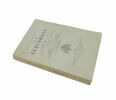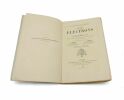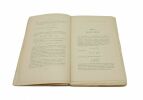LODGE, Sir Oliver
Sur les électrons
Paris, Gauthier-Villars, 1906, in-8, XIII-168 pp, Broché, couverture imprimée de l'éditeur, Édition originale de cette conférence d'Oliver Lodge (1851-1940), donné à l'Institution of Eectrical Engineers le 5 novembre 1902. Traduction de Nugues et Péridier. Oliver Lodge est connu pour ses travaux sur la télégraphie sans fil. Il était également spirite. Bon exemplaire. Couverture rigide
Reference : 89158
Bon XIII-168 pp.
Bookseller's contact details
Librairie Alain Brieux
Jean Bernard Gillot
48, rue Jacob
75006 Paris
France
331 42 60 21 98
Payment mode



Sale conditions
Vente aux conditions habituelles de la Librairie
5 book(s) with the same title
Lorentz (Hendrik-Antoon) - Peter Zeeman and A.D. Fokker, ed.
Reference : 100361
(1935)
Hendrik Antoon Lorentz - Collected Papers - Volume VIII (8) , (Das Licht und die Struktur der Materie - The Radiation of Light - How can Atoms Radiate ? - Positive and Negative Electricity - Ergebnisse und Probleme der Elektronentheory - The Experimental Foundations of the Theory of Electricity - On Positive and Negative Electrons - The Methods of the Theory of Gases Extended to other Fields - Nouveaux résultats dans le domaine des théories moléculaires - Anwendung der kinetischen Theorien und Elektronenbewegung - Notes sur la théorie des électrons - Application de la théorie des électrons aux propriétés des métaux - The Motion of Electricity in Metals - Elektromagnetische Theorien physikalischer Erscheinungen - Clerk Maxwell's Electromagnetic Theory - Quelques remarques sur la théorie du magnétisme - La liquéfaction de l'hélium - La prévision scientifique - Physics in the New and Old World)
Martinus Nijhoff, The Hague Malicorne sur Sarthe, 72, Pays de la Loire, France 1935 Book condition, Etat : Bon hardcover, editor's binding, full brown printed clothes, no dust-jacket, as issued grand In-8 1 vol. - 423 pages
1st edition, 1935 Contents, Chapitres : Contents, vi, Text, 417 pages - Das Licht und die Struktur der Materie - The Radiation of Light - How can Atoms Radiate ? - Positive and Negative Electricity - Ergebnisse und Probleme der Elektronentheory - The Experimental Foundations of the Theory of Electricity - On Positive and Negative Electrons - The Methods of the Theory of Gases Extended to other Fields - Nouveaux résultats dans le domaine des théories moléculaires - Anwendung der kinetischen Theorien und Elektronenbewegung - Notes sur la théorie des électrons - Application de la théorie des électrons aux propriétés des métaux - The Motion of Electricity in Metals - Elektromagnetische Theorien physikalischer Erscheinungen - Clerk Maxwell's Electromagnetic Theory - Quelques remarques sur la théorie du magnétisme - La liquéfaction de l'hélium - La prévision scientifique - Physics in the New and Old World - Hendrik Antoon Lorentz, né le 18 juillet 1853 à Arnhem (Pays-Bas) et mort le 4 février 1928 à Haarlem (Pays-Bas) est un physicien néerlandais qui s'est illustré par ses travaux théoriques sur la nature de la lumière et la constitution de la matière. Il est co-lauréat avec Pieter Zeeman du prix Nobel de physique de 1902. - La majorité de ses travaux portèrent sur l'électromagnétisme. Il a laissé son nom aux transformations de Lorentz qui sont à la base de la théorie de la relativité restreinte. Elles ont été présentées par Lorentz dans le but d'expliquer les résultats de l'expérience de Michelson-Morley par une contraction réelle des longueurs dans le sens du mouvement, ce qui n'est d'ailleurs pas compatible avec l'interprétation moderne de la théorie de la relativité restreinte qui affirme seulement que la mesure d'une distance ou d'une durée dépend du référentiel dans lequel se fait cette mesure et n'a donc pas de caractère absolu. La théorie de Lorentz implique également l'existence d'un référentiel absolu, le seul où les lois de l'électromagnétisme seraient applicables et d'un milieu, l'éther, qui servirait de support à la propagation des ondes électromagnétiques et qui serait fixe dans ce référentiel absolu. Lorentz partagea, en 1902, le prix Nobel de physique avec Pieter Zeeman « en reconnaissance des extraordinaires services qu'ils ont rendus par leurs recherches sur l'influence du magnétisme sur les phénomènes radiatifs ». (source : Wikipedia) Fine copy, no markings, inside is fine and complete, various papers, on matter, electron, molecular theory, electromagnetism or magnetism, among others - Volume 8 only on 9
La physique moderne et l'électron , Ions, électrons, protons et corpuscules divers, Les sources de l'électron, Le rôle de l'électron dans la science physique contemporaine, les applications de l'électron (2eme édition entièrement refondue)
Félix Alcan , Nouvelle Collection Scientifique Malicorne sur Sarthe, 72, Pays de la Loire, France 1935 Book condition, Etat : Bon broché, sous couverture imprimée éditeur orange In-8 1 vol. - 330 pages
45 figures dans le texte en noir et blanc 2eme édition, entièrement refondue (augmentée de 70 pages) Contents, Chapitres : 1. Propriétés générales de l'électron : Molécules et atomes - Les ions - L'électron - 2. Les sources d'électrons : Choc des ions contre les métaux - Emission thermo-électronique - Emission photo-électronique - Emission d'électrons par les substances radioactives - Emission d'électrons par les réactions chimiques - 3. Le rôle de l'électron dans la science physique et contemporaine : L'électron et la théorie moléculaire - La structure de l'atome - L'électron et l'électrostatique - Phénomènes dus à un mouvement électronique - L'électron et les théories de la lumière - Théorie électronique des métaux - L'électron et les théories du magnétisme - L'électron et les théories de la relativité - L'électron et la physique cosmique - Les propriétés ondulatoires des électrons - 4. Les applications de l'électron : Les rayons X - Les cellules photo-électriques - Lampes à deux et trois électrodes - L'arc électrique - Autres applications - Index bibliographique infime trace de pliure sur le coin inférieur du plat supérieur, sinon bel exemplaire, intérieur frais et propre, papier à peine jauni
LES QUANTITES ELEMENTAIRES D'ELECTRICITE - IONS, ELECTRONS, CORPUSCULES. CONTIENT entre autres mémoires, CEUX PUBLIES PAR : JJ. THOMSON, TOWSEND, GIESE, HERTZ, RUTHERFORD, PERRIN, BECQUEREL, Pierre CURIE, Marie CURIE, BLOCH, MacCLELLAND, LANGEVIN, MAC CLUNG, RIECKE, HELMHOLTZ, WILSON, PLUCKER, CROOKES, LENARD, GOLDSTEIN, WIEDMANN, EDISON, RICHARDSON, LORENTZ, POINTARE - etc ---- EDITON ORIGINALE ---- 2 VOLUMES (COMPLETE SET) ---- BEL EXEMPLAIRE
P., Gauthier-Villars, 1905, 2 fort volumes in 8 brochés couvertures imprimées, 16pp., 1138pp.
---- EDITION ORIGINALE - BEL EXEMPLAIRE ---- Dans ces 2 volumes, publié sous la direction de Langevin et Abraham, se trouvent REUNIS POUR LA PREMIERE FOIS LES MEMOIRES FONDAMENTAUX SUR LE SUJET PAR LES PLUS GRANDS PHYSICIENS DE L'EPOQUE. C'est certainement LA PLUS GRANDE CONTRIBUTION A L'INTELLIGENCE DES ELECTRONS EN 1905. De BECQUEREL à POINCARE, en passant par LORENTZ, on ne saurait citer tous les noms prestigieux qui font de cet ouvrage UN OUTIL ESSENTIEL A L'HISTORIEN DES SCIENCES ---- La notion de structure discontinue des charges électriques domine et pénètre la plupart des découvertes récentes en physique ; cette forme nouvelle des conceptions atomistiques sert maintenant de guide à un grand nombre d'expérimentateurs. C'est pour faciliter les recherches, autant que pour préciser les caractères essentiels des idées actuelles, que la Société Française de Physique a jugé utile de réunir un ensemble de travaux concernant les circonstances d'observation et les propriétés des centres électrisés, ions, électrons ou corpuscules. Cette collection de mémoires doit être surtout un livre de références qui mette sous la main des physiciens un certain nombre de travaux utiles à consulter. Les mémoires sont classés par ordre alphabétique de noms d'auteurs et par ordre chronologique pour chaque auteur. On peut donc ouvrir ce livre comme un dictionnaire... On trouvera dans ces mémoires des indications sur le rayonnement émis dans l'éther par les centres électrisés au moment où ils subissent une accélération ; on verra comment on en peut déduire l'explication des diverses radiations : lumière, rayons de Röntgen, rayons secondaires... . (Préface de P. Langevin et H. Abraham) ---- ABRAHAM (M.). Principes de la dynamique de l'électron, traduit par P. Langevin - AITKEN (J.). Poussière ; brouillards et nuages - BECQUEREL (H.). Extraits de diverses notes relatives au sujet - BLOCH (E.). Recherches sur les ions de faible mobilité - CROOKES. Sur la matière radiante - CURIE (Pierre. & Marie.). Extraits de diverses notes relatives au sujet - ARRHENIUS. Emission de particules électrisées par le soleil - HELMHOLTZ. Expriences avec un jet de vapeur. HELMHOLTZ & RICHARZ. Actions d'origine chimique et électrique influençant le jet de vapeur - HERTZ. Sur une influence de la lumière ultra-violette sur la décharge électrique - HURST & TOWNSEND. La productions des ions par le choc des ions positifs et théorie du potentiel disruptif - KAUFMANN. La déviabilité magnétique et électrique des rayons de Becquerel ; Sur la masse électromagnétique des éléctrons - LANGEVIN. Extraits de divers notes sur le sujet - LORENTZ. Sur la théorie des électrons ; Phénomènes électromagnétiques dans un système qui se meut avec une vitesse inférieure à celle de la lumière ; Emission et absorption par les métaux - PERRIN. Electrisation des rayons cathodiques et ionisation due aux rayons x - PLUCKER. De l'influence d'un aimant sur les décharges électriques dans les gaz raréfiés - POINCARE. Sur la dynamique de l'électron - RUTHERFORD. La mobilité des ions et leur vitesse de recombinaison dans les gaz röntgenisés ; Les rayons de l'uranium et la conduction électrique produite par eux ; La décharge des corps électrisés par la lumière ultra-violette ; La déviation électrique et magnétique des rayons peu pénétrants dur adium - RUTHERFORD & J.J. THOMSON. Sur le passage de l'électricité à travers les gas exposés aux rayons de Röntgen - STARK. L'origine des spectres électriques des gaz ; Sur l'ionisation par le choc des ions positifs et négatifs ; sur le mécanisme de l'arc électrique - THOMSON (J.J.). 11 MEMOIRES - TOWNSEND (J.). 10 MEMOIRES - LORENTZ, McCLELLAND, RICHARDSON, WIEN, WILSON, ZELENY - etc**3094/CAV.G3(3)-6871/CAV.E3-3095/M1
LES QUANTITES ELEMENTAIRES D'ELECTRICITE - IONS, ELECTRONS, CORPUSCULES. CONTIENT entre autres mémoires, CEUX PUBLIES PAR : J.J. THOMSON, TOWSEND, GIESE, HERTZ, RUTHERFORD, PERRIN, BECQUEREL, Pierre CURIE, Marie CURIE, BLOCH, MacCLELLAND, LANGEVIN, MAC CLUNG, RIECKE, HELMHOLTZ, WILSON, PLUCKER, CROOKES, LENARD, GOLDSTEIN, WIEDMANN, EDISON, RICHARDSON, LORENTZ, POINCARE - etc ---- EDITION ORIGNALE ---- 2 VOLUMES (COMPLETE SET)
P., Gauthier-Villars, 1905, 2 fort volumes in 8 reliés en demi-basane marron, dos ornés de filets dorés (reliures de l'époque), (dos frottés), 16pp., 1138pp.
---- EDITION ORIGINALE ---- Dans ces deux volumes, publiés sous la direction de Langevin et Abraham, se trouvent REUNIS POUR LA PREMIERE FOIS LES MEMOIRES FONDAMENTAUX SUR LE SUJET PAR LES PLUS GRANDS PHYSICIENS DE L'EPOQUE. C'est certainement LA PLUS GRANDE CONTRIBUTION A L'INTELLIGENCE DES ELECTRONS EN 1905. De BECQUEREL à POINCARE, en passant par LORENTZ, on ne saurait citer tous les noms prestigieux qui font de cet ouvrage UN OUTIL ESSENTIEL A L'HISTORIEN DES SCIENCES ---- "La notion de structure discontinue des charges électriques domine et pénètre la plupart des découvertes récentes en physique ; cette forme nouvelle des conceptions atomistiques sert maintenant de guide à un grand nombre d'expérimentateurs. C'est pour faciliter les recherches, autant que pour préciser les caractères essentiels des idées actuelles, que la Société Française de Physique a jugé utile de réunir un ensemble de travaux concernant les circonstances d'observation et les propriétés des centres électrisés, ions, électrons ou corpuscules. Cette collection de mémoires doit être surtout un livre de références qui mette sous la main des physiciens un certain nombre de travaux utiles à consulter. Les mémoires sont classés par ordre alphabétique de noms d'auteurs et par ordre chronologique pour chaque auteur. On peut donc ouvrir ce livre comme un dictionnaire... On trouvera dans ces mémoires des indications sur le rayonnement émis dans l'éther par les centres électrisés au moment où ils subissent une accélération ; on verra comment on en peut déduire l'explication des diverses radiations : lumière, rayons de Röntgen, rayons secondaires...". (Préface de P. Langevin et H. Abraham) ---- ABRAHAM (M.). Principes de la dynamique de l'électron, traduit par P. Langevin - AITKEN (J.). Poussière ; brouillards et nuages - BECQUEREL (H.). Extraits de diverses notes relatives au sujet - BLOCH (E.). Recherches sur les ions de faible mobilité - CROOKES. Sur la matière radiante - CURIE (Pierre. & Marie.). Extraits de diverses notes relatives au sujet - ARRHENIUS. Emission de particules électrisées par le soleil - HELMHOLTZ. Expriences avec un jet de vapeur. HELMHOLTZ & RICHARZ. Actions d'origine chimique et électrique influençant le jet de vapeur - HERTZ. Sur une influence de la lumière ultra-violette sur la décharge électrique - HURST & TOWNSEND. La productions des ions par le choc des ions positifs et théorie du potentiel disruptif - KAUFMANN. La déviabilité magnétique et électrique des rayons de Becquerel ; Sur la masse électromagnétique des éléctrons - LANGEVIN. Extraits de divers notes sur le sujet - LORENTZ. Sur la théorie des électrons ; Phénomènes électromagnétiques dans un système qui se meut avec une vitesse inférieure à celle de la lumière ; Emission et absorption par les métaux - PERRIN. Electrisation des rayons cathodiques et ionisation due aux rayons x - PLUCKER. De l'influence d'un aimant sur les décharges électriques dans les gaz raréfiés - POINCARE. Sur la dynamique de l'électron - RUTHERFORD. La mobilité des ions et leur vitesse de recombinaison dans les gaz röntgenisés ; Les rayons de l'uranium et la conduction électrique produite par eux ; La décharge des corps électrisés par la lumière ultra-violette ; La déviation électrique et magnétique des rayons peu pénétrants dur adium - RUTHERFORD & J.J. THOMSON. Sur le passage de l'électricité à travers les gas exposés aux rayons de Röntgen - STARK. L'origine des spectres électriques des gaz ; Sur l'ionisation par le choc des ions positifs et négatifs ; sur le mécanisme de l'arc électrique - THOMSON (J.J.). 11 MEMOIRES - TOWNSEND (J.). 10 MEMOIRES - LORENTZ, McCLELLAND, RICHARDSON, WIEN, WILSON, ZELENY - etc**3095/M1-6871/CAV.E3-3094/CAV.G3(3)
"STONER, EDMUND C. - STONERS RULE - ANTICIPATING PAULI'S EXCLUSION PRINCIPLE.
Reference : 47277
(1924)
The Distribution of Electrons among Atomic Levels.
London, Taylor & Francis, 1924. Full buckram. Spine with gilt lettering. Stamps on titlepage. Bookmark of ""Pomona College Library"" on inside frontcover. In: ""The London, Edinburgh, and Dublin Philosophical Magazine and Journal of Science"", Vol. XLVIII, Sixth Series. VIII,1144 pp., textillustr. and 27 plates. (Entire volume offered). Stoner's paper: pp. 719-736.
First apperance of Stoner's importent paper in which he formulated ""Stoner's Rule"", a paper which inspired Pauli to his Exclusion principle in 1925. ""The publication of his paper (the paper offered) brought Stoner rapid recognition. His theory, however, was subsequently overshadowed by the exclusion principle of Wolfgang Pauli, who, exploiting Stoner’s insight and applying it to individual electrons, transformed it into a general and powerful analytic tool."" (DSB).""In 1924 (in the paper offered) Stoner had proposed the following rule: ""The number of electrons in each completed shall is equal to double the sum of the inner quantum numbers"".... Stoner's rule says: a shell corresponds to a fixed n and the number of electrons in that shell, if completetely filled. equals twice N.... Why twice ?... Here Pauli takes over.""(Pais ""Inward Bound"", p. 273.).""Soon after Bohr developed his initial configuration, Arnold Sommerfeld in Munich realized the need to characterize the stationary states of the electron in the hydrogen atom by means of a second quantum number-the socalled angular-momentum quantum number. Bohr immediately applied this discovery to many-electron atoms and in 1922 produced a set of more detailed electronic configurations. In turn, Sommerfeld went on to discover the third, or inner, quantum number, thus enabling the British physicist Edmund Stoner to come up with an even more refined set of electronic configurations in 1924..... Stoner assumed that three quantum numbers could be specified in many electron atoms. In any case, Stoner’s scheme solved certain problems present in Bohr’s configurations. For example, Bohr had assigned phosphorus the configuration 2,4,4,4,1, but this failed to explain the fact that phosphorus shows valencies of three and five. Stoner’s configuration for phosphorus was 2,2,2,4,2,2,1, which easily explains the valencies, since it becomes plausible that either the two or the three outermost subshells of electrons form bonds."" (Eric R. Scerri. ""The Periodic Table and the Electron"").
 Write to the booksellers
Write to the booksellers




